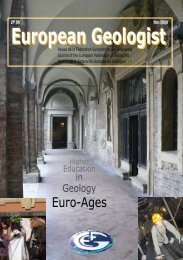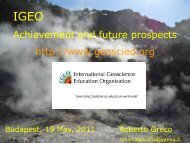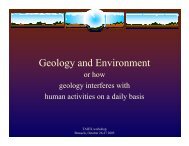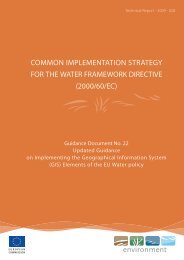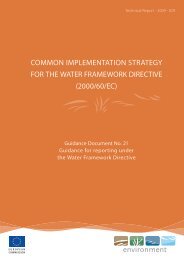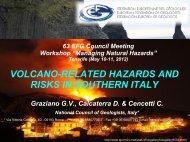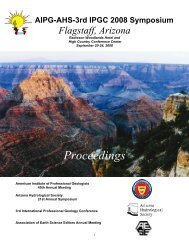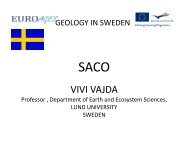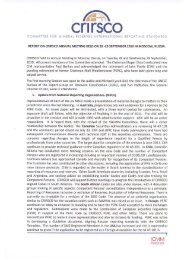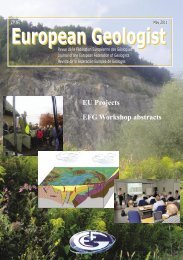European Geologist European Geologist Geoheritage - learning ...
European Geologist European Geologist Geoheritage - learning ...
European Geologist European Geologist Geoheritage - learning ...
Create successful ePaper yourself
Turn your PDF publications into a flip-book with our unique Google optimized e-Paper software.
consisting of scoria, lapilli and basalt,<br />
includes permanent exhibition rooms<br />
located mainly between 13 m and 20 m<br />
below the surface. They are connected<br />
locally to the surface through a luminous<br />
well, a glass oculus or semi-buried greenhouse.<br />
The Cone and the restaurant are<br />
the only buildings visible in the natural<br />
landscape.<br />
A sensational gallery dug through the<br />
trachy-andesitic lava flow evokes a travel to<br />
the Earth’s centre discovering legends and<br />
myths concerning the relationships between<br />
man and volcanoes; the visitor thus arrives<br />
in a volcanic garden bathed in sunlight, protected<br />
by a glass casing and can walk among<br />
exotic plants, six metre high tree-ferns, and<br />
other species growing on extrusive rocks.<br />
Different areas are devoted to the Solar<br />
system and to the particular volcanoes<br />
discovered by space probes, from Martian<br />
structures to the powerful eruptions<br />
affecting Jupiter’s Galilean moon, Io, and<br />
the craters of Venus.<br />
On the ground, a luminous cross-section<br />
of the globe, nine metres in diameter,<br />
reveals the Earth’s structure, with its plate<br />
movements, and shows the continuous slow<br />
convective stirring affecting the Earth’s<br />
mantle. This interactive floor houses “popups”,<br />
short movies explaining the main phenomena<br />
of the mantle and the deep regions<br />
of our planet.<br />
The tourist in a hurry can simply refer<br />
to a display synthesizing the site’s contents<br />
Figure 3: Sight by night.<br />
Figure 4: Volcanic garden.<br />
and requiring only a few minutes attention,<br />
but the mean visit duration is actually six<br />
and a half hours.<br />
The history of the Earth, from its birth<br />
4.6 billion years ago to the present Global<br />
Change events, with its magnetic field, plate<br />
tectonics, earthquakes and volcanoes, are<br />
clearly explained and illustrated.<br />
Among the key elements of interest available<br />
to the visitor are:<br />
• the Cone, 28 m high, located in front<br />
of the Puy de Dôme, the main volcanic<br />
dome of the Chaîne des Puys,<br />
and covered with volcanic rocks;<br />
• the Crater that is reached via a spiral<br />
ramp, 38 m deep dug through lava.<br />
Impressive special effects include<br />
muffled roaring, spouting fumaroles<br />
and reddish glares at the crater<br />
bottom;<br />
• pedagogic spaces for pupils and students<br />
allowing geological debates<br />
about topics fitted to teacher and<br />
pupil needs.<br />
Beyond the volcanoes, a panel showing<br />
the phenomena linked to their decline and<br />
inactivity is displayed. Geysers, solfatara,<br />
thermal or thermo-mineral springs and<br />
geothermal energy, mofettes, slow concentration<br />
of ores or slow crystallization<br />
of gems in the heart of ancient volcanoes<br />
or lodes, use of volcanic materials for the<br />
construction are also explained.<br />
Today the public is eager to get information<br />
about the main challenges linked<br />
to natural risks, natural resources scarcity<br />
and environmental or climatic hazards.<br />
Since explanations provided by the media<br />
are often variably succinct or abstruse, the<br />
Vulcania scientific team is involved in discussing<br />
recent dramatic events: the volcanic<br />
eruption in Iceland (Eyjafjallajökull, 2010)<br />
or Indonesia (Merapi, 2011); the earthquakes<br />
in Banda Aceh (Sumatra, 2004),<br />
in Haïti, (2010) or in Japan (Sendaï, 2011)<br />
with the associated devastating tsunamis.<br />
Understanding the origin of tornadoes<br />
and droughts are also themes which interest<br />
tourists who appreciate the presence of<br />
passionate scientists able to answer their<br />
questions in easily understood language.<br />
Conference sessions enlivened by wellknown<br />
scientists reinforce this communication<br />
mission.<br />
Every year, Vulcania opens new and<br />
spectacular attractions: in 2010, Machine<br />
Earth and Unveiled Planet, explored the<br />
raised relief earth allowing the visitor to<br />
select his own Earth’s segment. In 2011, Mission<br />
TOBA enabled the visitor to fly above<br />
a super volcano in Indonesia (2,800 cubic<br />
km of tephra erupted 74,000 years ago),<br />
and to visit the Tunnel of the incandescent<br />
ash-clouds, and a new temporary exhibition<br />
room: the Volcano Devils, commemorating<br />
the 20 th anniversary of the death of the<br />
Krafft volcanologists. The Krafft family<br />
have indeed donated to Vulcania the core<br />
of their collections built during their scientific<br />
volcanic explorations all over the<br />
world. This year (2012), there were entertaining<br />
attractions for children, the result<br />
of a partnership with Universcience (Paris):<br />
the Children’s City.<br />
Each exhibition or leisure area is<br />
equipped with up-to-date technologies:<br />
raised relief holograms, rotating seats,<br />
earthquake simulators, tactile tablets, rotating<br />
platforms, special effects, etc. The various<br />
presentation units are independent and<br />
self expressive. An emphasis is put on the<br />
immediate visualization of the important<br />
messages portrayed. Each thematic unit is<br />
shown with variable objectives encouraging<br />
participation by the explorer, who is<br />
not only a spectator but a dynamic actor<br />
in this discovery.<br />
Vulcania also plays a role as an interface<br />
relaying laboratory research to the public<br />
through several partnerships such as the<br />
laboratory “Magma and volcanoes” (CLER-<br />
VOLC) from the Blaise Pascal University in<br />
Clermont-Ferrand.<br />
Vulcania is an active mover in the cultural<br />
development of the Auvergne region,<br />
successfully harmonizing culture, various<br />
partnerships, territorial environmental protection<br />
and tourism.<br />
For the students temporarily attached to<br />
the Park, their training is seen as a first step<br />
in developing competences, particularly in<br />
terms of oral communication and mediation<br />
of scientific themes.<br />
Vulcania, without any equivalent in<br />
Europe, is dedicated to the knowledge of<br />
our planet. Promoting Earth Sciences, this<br />
site will continue its mission as a scientific<br />
culture centre, opened to all the visitors to<br />
this attractive area in central France.<br />
Photos from Jerôme Chabanne,<br />
www.vulcania.com<br />
18



